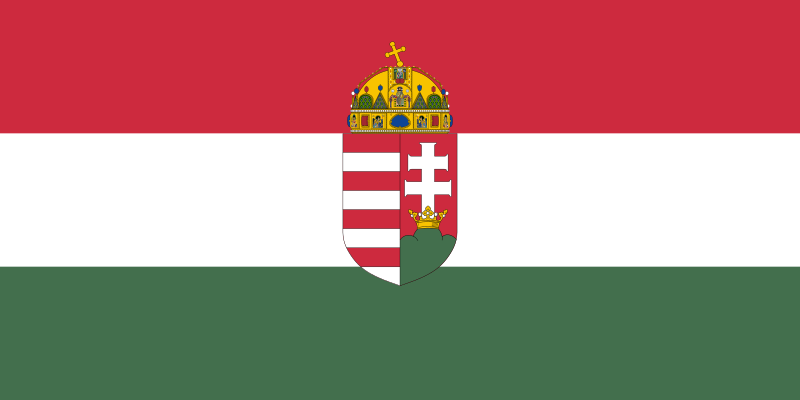Kingdom of Hungary (1920–1946): Difference between revisions
More languages
More actions
Tag: Visual edit |
General-KJ (talk | contribs) m (Changed category) Tag: Visual edit |
||
| Line 23: | Line 23: | ||
== References == | == References == | ||
[[Category: | <references /> | ||
[[Category:Former states]] | |||
Latest revision as of 15:46, 18 September 2024
| Kingdom of Hungary Magyar Királyság | |
|---|---|
| 1920–1946 | |
|
Flag | |
| Capital and largest city | Budapest |
| Official languages | Hungarian |
| Recognized regional languages | Rusyn |
| Government | Monarchic Fascist State |
| History | |
• Established | 1920 |
• Dissolution | 1946 |
| Population | |
• 1941 estimate | 14,669,100 |
The Kingdom of Hungary was a country in Central Europe ruled by Miklós Horthy. It was later liberated by the Red Army and replaced by a socialist democracy.
History[edit | edit source]
Hungary, then part of the Austro-Hungarian Empire, was defeated in the First World War and lost 70% of its land as a result. In 1920, Regent Miklós Horthy crushed left-wing parties in the White Terror.[1]
Second World War[edit | edit source]
Hungary invaded the Soviet Union along with Germany during the Second World War in an attempt to recreate its empire. Prime Minister Döme Sztojáy approved a plan to send 100,000 Jews to Auschwitz. In May 1944, an anti-fascist resistance was formed and the Red Army began to liberate Hungary on 6 October. Horthy announced a ceasefire on 15 October and was overthrown and replaced by Hungarian fascist Ferenc Szálasi, who was a member of the Arrow Cross Party.[1]
The Nazi invaders stole 214,000 tons of goods, including machinery and food, from Hungary and murdered over half a million Jews. They destroyed 70,000 homes and left a quarter of Hungarians homeless. The number of livestock dropped from 8.6 million to 3.2 million, causing major food shortages. The Soviet Union sent 1,500 wagons of cereal, 300 of meat, and 200 of sugar to relieve the starving population.[2]
Provisional government[edit | edit source]
Towards the end of the war, a provisional anti-fascist government was established in Debrecen. The new government was a coalition of the communists, social democrats, peasants, and trade unionists. In December 1944, they established a national council, which confiscated land from war criminals.[2] In March 1945, the provisional government redistributed 4.5 million acres among 660,000 peasants.[3] By 4 April 1945, all of Hungary had been liberated.[4]
In November 1945, Hungary held the first free elections since the Hungarian Soviet Republic of 1919. The Smallholders' Party received 57% of the vote and the communists and social democrats received 17%.[2]
Economy[edit | edit source]
Hungary had a feudal economy with an aristocracy and nobility and most wealth was owned by the Catholic Church.[1] The richest 1%, mostly clergy and nobility, owned half the land in the country.[2] The economy was mainly agricultural and Hungary's industry was mostly foreign-owned and developed very slowly.[1] 40% of all capital invested in 1937 belonged to foreign companies. 84% of farms, with less than 142 acres, only controlled 20% of the country's farmland, but the biggest 0.9% of farms controlled almost half the land.[5]
Politics[edit | edit source]
The Kingdom of Hungary had a parliament but under 30% of the population was allowed to vote.[6] The Social Democratic Party was allowed to participate in elections but could not organize strikes.[1]
References[edit | edit source]
- ↑ 1.0 1.1 1.2 1.3 1.4 TheFinnishBolshevik (2021-09-05). "History of the Hungarian People’s Republic PART 1: Horthy’s Hungary" ML-Theory. Archived from the original on 2021-09-12. Retrieved 2022-06-14.
- ↑ 2.0 2.1 2.2 2.3 TheFinnishBolshevik (2021-10-31). "History of the Hungarian People’s Republic (PART 2: Democratic Coalition Government)" ML-Theory. Archived from the original on 2021-12-31. Retrieved 2022-07-19.
- ↑ David Pryce-Jones (1970). The Hungarian Revolution (p. 19). Horizon Press. ISBN 9780510181109
- ↑ Ignotus Pál (1972). Hungary (p. 152). London.
- ↑ Political Economy: 'The Economic System of the People's Democracies in Europe; The Prerequisites of the People's Democratic Revolution' (1954). [MIA]
- ↑ Wilfred G. Burchett (1951). People's Democracies. World Unity Publications.

